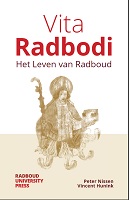Vita Radbodi
Het Leven van Radboud
| dc.contributor.author | Nissen, Peter | |
| dc.contributor.author | Hunink, Vincent | |
| dc.date.accessioned | 2023-10-23T11:41:59Z | |
| dc.date.available | 2023-10-23T11:41:59Z | |
| dc.date.issued | 2023 | |
| dc.identifier | OCN: 1406070035 | |
| dc.identifier.uri | https://library.oapen.org/handle/20.500.12657/77004 | |
| dc.description.abstract | The Low Countries in the early Middle Ages. Christianity is on the rise, partly due to the efforts of missionaries such as Willibrord and Boniface. Yet the process of Christianisation is laborious. This is well illustrated in Vita Radbodi, a tenth-century Latin biography of bishop Radboud of Utrecht (c. 850-917). In it, Radboud is depicted as a pious, serious and studious young man, who is called to the episcopate after many years of study. As bishop, he encounters problems with unbelieving Frisians and ferocious Normans. Thus, he is forced to move his seat from Utrecht to the safer Deventer. The text offers a positive portrait of Radboud as a holy role model figure. He acts energetically, performs miracles and, of course, also possesses prophetic gifts. For instance, he predicts his own end well in time. The text ends with a vision of the Mother of God and Radboud's death and burial. Some twenty years after the first edition by Peter Nissen and Vincent Hunink, the text is now being reissued on the occasion of Radboud University's centenary. | en_US |
| dc.language | Dutch | en_US |
| dc.language | Latin | en_US |
| dc.subject.other | Christianity; Latin; Medieval Literature; Hagiography; Medieval Latin | en_US |
| dc.title | Vita Radbodi | en_US |
| dc.title.alternative | Het Leven van Radboud | en_US |
| dc.type | book | |
| oapen.identifier.doi | 10.54195/JRSH2039 | en_US |
| oapen.relation.isPublishedBy | 3237ffdf-4cb3-49a0-8415-ceba8c0cba23 | en_US |
| oapen.pages | 85 | en_US |
| oapen.place.publication | Nijmegen | en_US |

